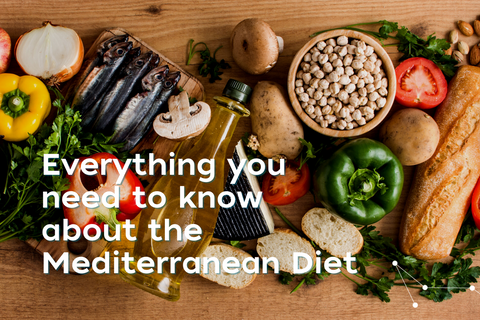The Mediterranean Diet (Med Diet; or MD) is one of the most widely studied dietary patterns in the world. This way of eating is based on traditional foods and eating patterns from the countries and people surrounding the Mediterranean Sea during the 1950s and 1960s including Greece, Italy and Spain. Radd-Vagenas et al defined the traditional Mediterranean diet well, “When the ratio of plant versus animal foods is considered, the ‘traditional’ Mediterranean diet presents as a semi-vegetarian diet, abundant in unrefined plant foods with a notable absence of ultra-processed foods, such as extruded snacks, sugary foods and drinks, fast foods and refined fats and oils, now commonplace in modern day diets”. The diet consists of fish and lean protein, monounsaturated fats from olive oil, fruits, vegetables, whole grains, legumes/nuts and moderate consumption of red wine. From a nutritional view point, the Med Diet is low in saturated fats and animal protein, rich in antioxidants, fibre and monounsaturated fats and shows an adequate ratio of omega-6/omega3 fatty acids. Adherence to this diet has been associated with lowered risk of mortality, cardiovascular disease, metabolic disease and cancer
“Epicurean philosophy developed the theory of the pleasure of eating, in opposition to behavioural excesses and greed; the meal not only had to nourish, but also stimulate the spirit.”
Over the last century, scientists have examined the relationship between diet, lipoprotein metabolism, inflammation and atherosclerosis resulting in the discovery of role that cholesterol-rich diets play in the pathogenesis of atherosclerosis. Adherence to the Med Diet is associated with anti-atherogenic effects seen through a reduction in blood pressure and levels of bad cholesterol, as well as decreased oxidative stress, endothelial dysfunction and vascular inflammation.
The foods that form the Med Diet were chosen based on the type of agriculture, pastoralism and fishing surrounding the Mediterranean bioregion at the time. It is said that the ancient Greeks paid special attention to their nutrition, believing a correct diet was a prerequisite for physical and mental health. The Greek playwright Antiphanes (circa 404–330 BC) nicknamed the Greeks “leaf chewers”, to emphasize their very rich diet in vegetables. According to the Orphic and Pythagorean teachings, meat was rarely consumed (also because it was expensive), while fish was more popular than meat.
Fish and Seafood
Marine sources of omega-3 fatty acids contain high amounts of polyunsaturated fatty acids (PUFA). These sources include sardines, mackerel, mussels, octopus, oysters, salmon, sea bass, shrimp, squid and tuna. Recommendations from the American Health Association and European guidelines endorse the regular consumption of fish for primary prevention (preventing onset of disease in the first place) and secondary prevention (to prevent already established disease from getting worse) of cardiovascular disease and possibly protection from dysrhythmia (abnormal heart rhythms). Multiple meta-analyses support increased consumption of fish in reducing mortality and morbidity from cardiovascular disease with an increase in fish intake (40-60 grams/day or 1-2 times/week) in high-risk populations. The mechanical benefits of the PUFA include an improvement in lipid profiles and reduced blood pressure thought to be due to reduced inflammation, oxidation and blood coagulation. Independent of their inclusion in the Med Diet, fish intake supports a heart-healthy diet.
Extra-Virgin Olive Oil (EVOO)
Extra Virgin Olive Oil (EVOO) is a key component of the Med Diet. Suggested anti-inflammatory and anti-atherogenic properties of olive oil were supposedly attributed to its high content of monounsaturated fatty acids (MUFA, specifically oleic acid), and some more recent investigations also suggest that bioactive polyphenols, which are only present in the EVOO, may contribute to these cardioprotective actions. EVOO is abundantly used in salads, traditionally cooked vegetables and legumes and alongside with moderate consumption of red wine during meals which contributes to palatability and high nutritional value. The PREDIMED primary prevention study looked at persons at high risk for cardiovascular events and found that those who were supplemented with EVOO or nuts alongside an energy-unrestricted Mediterranean diet and were found to have lower rates of major cardiovascular events than those who followed a reduced fat diet.
Fruit and Vegetables
The traditional Med Diet follows an emphasis on seasonal, field-grown fruits and vegetables. Vegetables are the most important sources of phenolic compounds (mainly flavonoids), as well as many other nutrients such as dietary fibre (which has shown to reduce the response of insulin to carbohydrates), as well as potassium, vitamin A, vitamin C, Vitamin K, copper, magnesium, vitamin E, vitamin B6, folate, iron, thiamine, niacin and choline. Common sources of vegetables include fresh salads, tomato, eggplant, cucumber, rocket, radishes, garlic, onion, spinach and lettuce. The frequently consumed fruits include citrus fruits (oranges, pomegranates, berries, figs, grapes, apricots, peaches, nectarines and cantaloupes. Fruits also provide a rich source of dietary fibre, vitamin C and flavonoids. Intakes of three to four servings of fruit and vegetables per day (equivalent to 375–500 g/day) has been shown to be beneficial in reducing overall mortality. High intakes of fruits have also been observed to lower the risk of adiposity (body fat composition), hypertension, Type 2 diabetes, stroke and coronary heart disease. A study undertaken by The Lancet showed an 11% lowered risk of cardiovascular disease for higher fruit intake when compared to the lowest intake.
Whole Grains
Whole grains are important sources of nutrients including dietary fibre, iron, zinc, manganese, folate, magnesium, copper, thiamine, niacin, vitamin B6, phosphorus, selenium and riboflavin. Studies have shown a beneficial effect of an increased intake of whole grains on morbidity and mortality from cardiovascular disease (CVD) , coronary heart disease (CHD) and stroke. Currently, the recommended dietary servings for whole grains are between 4-6 per day; however, relatively few people will have three or more serves of whole grains per day. A serving of whole grains or complex carbohydrates (30g) can include ½ cup cooked pasta, rice, buckwheat, quinoa, ½ cup cooked porridge, or 1 slice of bread. One study found the largest reductions in coronary heart disease, mortality from cancer, respiratory disease and all non-cardiovascular, non-cancer causes of death with intakes as high as 210-225g/day (which reflects seven to seven and a half servings per day). In other words, greater consumption of wholegrains in the diet is likely to confer important health benefits.
Nuts and legumes
Legumes commonly consumed in the Med Diet include chickpeas, lentils and beans. High in protein, fibre, phytosterols, folate, vitamin B6, flavones and various minerals. Legumes have been associated with lowered risks of all-cause mortality and coronary heart disease in dose-response meta-analyses of prospective observational studies (i.e. studies that follow populations of people over time). Nuts that are frequently consumed in the Med Diet include pistachios, almonds, peanuts, hazelnuts and walnuts. Walnuts are a particularly rich source of alpha linolenic acid (ALA) and have also been shown to have the highest level of phenolic compounds when compared to other nuts. Nuts are known to be important sources of monounsaturated (MUFAs) and polyunsaturated fatty acids (PUFAs), phenols, flavonoids, isoflavonoids, phytosterols and phytic acid, vitamin E, vitamin B2, folate and fibre as well as minerals and trace elements such as magnesium, phosphorus, potassium, copper and selenium. Systematic reviews and meta-analyses of controlled studies have demonstrated tree nut consumption can lower total cholesterol, LDL cholesterol (bad cholesterol), Apolipoprotein-B and triglycerides, which may confer important health benefits in lowering important risk factors involved in the pathogenesis of cardiovascular disease.
Red wine
Moderate, regular alcohol consumption, mainly red wine, is suggested to play a role in the prevention of CVD and can reduce the incidence of several cancers and other chronic diseases, including T2DM and neurodegenerative disorders. Red wine is known to contain approximately 1.9g/L of total polyphenols, which is 10-fold more phenolic compounds than white wine. Polyphenols have been suggested to demonstrate a number of biological activities including hormonal regulation and antioxidant, anti-inflammatory, anti-microbial, anti-proliferative and pro-apoptotic effects (apoptosis = cell death). Moderate consumption of alcohol (30g alcohol/day) in the form of red wine has been shown to raise high-density lipoprotein cholesterol (HDL-C) concentrations (i.e. good cholesterol). The polyphenol content affects apolipoproteins A and B, the Very Low Density Lipoproteins (VLDL) particles, and reduces plasma triglyceride levels by increasing activity of lipoprotein lipase (LPL) which also decreases low-density lipoprotein cholesterol (LDL-C) concentrations. It must be noted however, that this intake should be consumed at a low to moderate level in line with traditional Mediterranean Diet patterns of consumption.
Conclusions
Arguably, the Mediterranean Diet is the most highly evidence-based diet for conferring important human health benefits. Notably, the Mediterranean Diet has been shown to confer up to 30% reduction in risk of cardiovascular disease at 5 years. It may also assist in lowering risk of or mitigating severity of type 2 diabetes, as well as reducing risk of certain cancers including colorectal and breast cancer, and assist in weight loss and weight maintenance. The Med Diet has become a well-recognised and widely adopted dietary template and a standard for healthy eating. As with anything, too much of a good thing is not necessarily good for you, and the same applies to the Mediterranean Diet. Due to some of the nutrient and caloric-dense foods consumed in the Med Diet, these should be consumed in moderation to ensure that caloric excess is avoided. It is also important to note that no specific single component of the Mediterranean diet has been shown to be as beneficial as including all aspects as a whole.
Examples of some changes you could make to adopt a Mediterranean-focussed diet include:
- Breakfast: Sourdough bread toasted with a slice of avocado, a poached egg and a drizzle of olive oil with cracked black pepper alongside a herbal tea or short black coffee.
- Lunch: Mixed salad with beans and tuna or salad with a small bunch of grapes or a piece of fruit
- Snack: Small bowl of Greek-style natural yoghurt topped with crushed walnuts and a drizzle of honey.
- Dinner: Baked fish with baked potato (dressed with olive oil, grated fresh tomato, crushed garlic and fresh herbs) paired with a leafy green salad with lemon juice and olive oil as a dressing and an optional glass of wine
*it should be noted that these are just examples of what a Mediterranean diet might look like and dietary habits should be tailored to individual needs.
Simple dietary changes:
- Using extra virgin olive oil instead of other oils/fats for cooking and dressing salads and cooking vegetables
- Consuming vegetables with every meal (including leafy greens and tomatoes)
- Consuming 2-3 serves of fresh fruit per day
- Consuming legumes (cooked dried beans) 3 times per week (in salads, soups, casseroles, veggie burgers, falafel)
- Having 2-3 serves of fish or seafood per week (at least one oily fish such as salmon or sardines)
- Choosing white meat (poultry without the skin or rabbit) instead of fatty processed meats (sausages, burgers) and keeping any red meat portions small and lean
- Choosing natural (unsweetened) yoghurt as a snack on most days
- Cooking regularly (at least twice per week) with tomato, garlic, onion, and aromatic herbs as a base for pasta sauces, casseroles and baked dishes
Reducing the consumption of:
- Cream, butter, margarine
- Processed meats (sausages, salami), fatty meats and poultry skin, and deep-fried battered foods
- Carbonated and sugary beverages
- Pastries, cakes, sweet biscuits and lollies
- Processed savoury snacks (potato chips, savoury biscuits)
References:
- Aune, D., Keum, N., Giovannucci, E., Fadnes, L. T., Boffetta, P., Greenwood, D. C., Tonstad, S., Vatten, L. J., Riboli, E., & Norat, T. (2016). Whole grain consumption and risk of cardiovascular disease, cancer, and all cause and cause specific mortality: systematic review and dose-response meta-analysis of prospective studies. BMJ (Clinical research ed.), 353, i2716. https://doi.org/10.1136/bmj.i2716
- Del Gobbo, L. C., Falk, M. C., Feldman, R., Lewis, K., & Mozaffarian, D. (2015). Effects of tree nuts on blood lipids, apolipoproteins, and blood pressure: systematic review, meta-analysis, and dose-response of 61 controlled intervention trials. The American journal of clinical nutrition, 102(6), 1347–1356. https://doi.org/10.3945/ajcn.115.110965
- Ditano-Vázquez, P., Torres-Peña, J. D., Galeano-Valle, F., Pérez-Caballero, A. I., Demelo-Rodríguez, P., Lopez-Miranda, J., Katsiki, N., Delgado-Lista, J., & Alvarez-Sala-Walther, L. A. (2019). The Fluid Aspect of the Mediterranean Diet in the Prevention and Management of Cardiovascular Disease and Diabetes: The Role of Polyphenol Content in Moderate Consumption of Wine and Olive Oil. Nutrients, 11(11), 2833. https://doi.org/10.3390/nu11112833
- Estruch, R., Rod, E., Salas-Salvado, J., Covas, M., Corella, D., et al. (2018). Primary Prevention of Cardiovascular Disease with a Mediterranean Diet Supplemented with Extra-Virgin Olive Oil or Nuts. The New England Journal of Medicine, 378(34). https://www.nejm.org/doi/full/10.1056/NEJMoa1800389
- RACGP (2014). Mediterranean diet for reducing cardiovascular - https://www.racgp.org.au/clinical-resources/clinical-guidelines/handi/handi-interventions/nutrition/mediterranean-diet-for-reducing-cardiovascular-dis#mealplan
- Radd-Vagenas, S., Kouris-Blazos, A., Singh, M., Flood, V. (2017). Evolution of Mediterranean diets and cuisine: concepts and definitions. Asia Pacific Journal of Clinical Nutrition, 26(5): 749-763. https://apjcn.nhri.org.tw/server/APJCN/26/5/749.pdf
- Romagnolo, D. F., & Selmin, O. I. (2017). Mediterranean Diet and Prevention of Chronic Diseases. Nutrition today, 52(5), 208–222. https://doi.org/10.1097/NT.0000000000000228
- Martinez-Gonzalez, M., Gea, A., Ruiz-Canela, M. (2019). The Mediterranean Diet and Cardiovascular Health. American Heart Association, 124(5), 779-798. https://doi.org/10.1161/CIRCRESAHA.118.313348
- Miller, V., Mente, A., Dehghan, M., Rangarajan, S., Zhang, X., Swaminathan, S. et al. (2017). Fruit, vegetable and legume intake , and cardiovascular disease and deaths in 18 countries (PURE): a prospective cohort study. The Lancet, 390(10107), 2037-2049. https://doi.org/10.1016/S0140-6736(17)32253-5
- Minelli, P., & Montinari, M. R. (2019). The Mediterranean Diet And Cardioprotection: Historical Overview And Current Research. Journal of multidisciplinary healthcare, 12, 805–815. https://doi.org/10.2147/JMDH.S219875
- Schwingshackl, L., Morze, J., & Hoffmann, G. (2020). Mediterranean diet and health status: Active ingredients and pharmacological mechanisms. British journal of pharmacology, 177(6), 1241–1257. https://doi.org/10.1111/bph.14778
- Ventriglio, A., Sancassiani, F., Contu, M. P., Latorre, M., Di Slavatore, M., Fornaro, M., & Bhugra, D. (2020). Mediterranean Diet and its Benefits on Health and Mental Health: A Literature Review. Clinical Practice and Epidemiology in Mental Health: CP & EMH, 16(Suppl-1), 156–164. https://doi.org/10.2174/1745017902016010156
- Widmer, R. J., Flammer, A. J., Lerman, L. O., & Lerman, A. (2015). The Mediterranean diet, its components, and cardiovascular disease. The American Journal of Medicine, 128(3), 229–238. https://doi.org/10.1016/j.amjmed.2014.10.014



